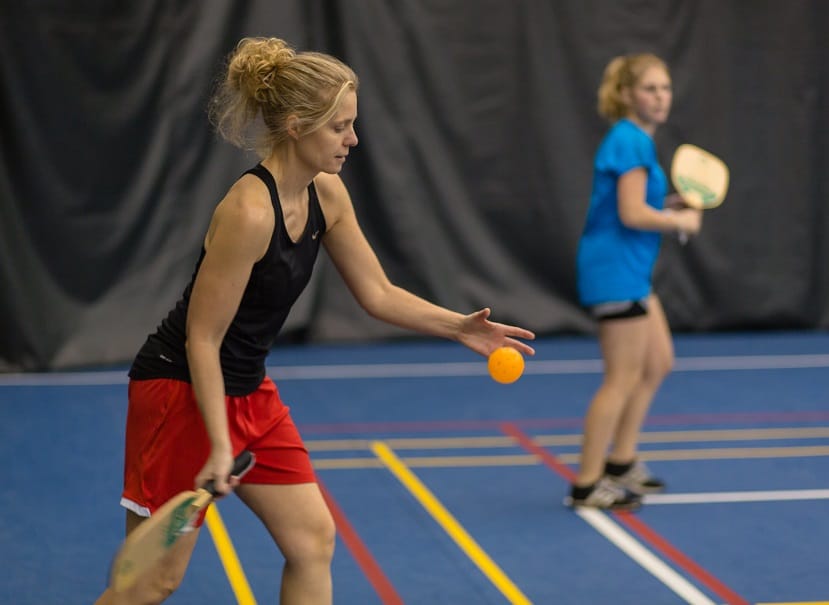Is tagging fair-play in pickleball or should the ethics of the game be called into question for this? Tagging is a common enough occurrence or a tactic in pickleball that it merits a discussion of its own and in this piece below we discuss the same in depth.
Let’s begin the very basic question, i.e. the definition of tagging in pickleball before we move towards the legalities and the ethical conundrum associated with it.
Table of Content
What is Tagging in Pickleball?
The act of deliberately aiming to hit the opponent on his or her body in the game of pickleball is called tagging.
The end goal of tagging might be to win a point but if done advertently it could lead to question of ethics and morals, especially in a more social setting because there’s nothing in the rule-book that prevents tagging as a rule.
Typically players end up tagging their opponents when they find their paddle low, allowing them to smash one straight into their chest area.
Also Read:
Why is Pickleball Tagging Frowned Upon?
To the onlooker or to those who haven’t played pickleball very regularly, or even to those who are not averse to tagging in pickleball, the question that might come to mind is why should we even have a discussion around it?
If it’s allowed in the rules, then let’s get on with the game, right? Some might even claim, it’s better to stay out of the kitchen, both literally and figuratively speaking, if one cannot handle the heat.
That doesn’t mean, however, there is no other side of the story though.
The problem for some is that pickleball is a social game and while rules allow tagging, social norms of not wanting to deliberately hurt an opponent should be followed. It becomes a matter of ethics, a matter of not wanting to win at all costs to some.
Pickleball injuries are common – we reckon it’s important to wear pickleball eyewear to protect oneself from errant pickleballs – and tagging could lead to those (the issue then is protection of the other parts like shoulder, neck, chest and the torso).
More so, if the ball is hit with force above the chest area, which could more serious injuries when the level of pickleball isn’t the strongest.
If you end up hitting someone inadvertently in a game of pickleball, it behooves you to immediately apologize to your opponent. It might not take the physical pain away but is a way of reassuring them it wasn’t done out of malice or a win-at-all-cost attitude.
What do Opponents of Tagging Suggest?
There is a general view among the opponents of tagging that in recreational play, it should be totally banned. Some even reckon club managers should take complaints seriously and permanently ban players who tag their opponents deliberately.
At a professional level, the opponents of tagging want referees to take notice and stop play if it becomes a norm. Point penalty or ejection from the tournament could be added to the rule book if the referee deems it right.
The basic reason behind the aforementioned is safety, something that opponents of this tactic are fully behind.
What do Pickleball Tagging Backers Say?
For one, those backing tagging reckon it’s a part of the game and here to stay.
One of the more rational views supporting tagging is it would be very difficult for referees and umpires to distinguish between intentional and unintentional tagging.
That is difficult enough even on replays but to the naked eye, which is what the case would be at the recreational level, it would be bordering on the impossible.
Interestingly, in an article on Pickleball Central, there is a case being made of pickleball having become a contact sport. Glen Peterson says,
Hitting an opponent is a winning shot … and often brings a psychological advantage. Taller, larger opponents make bigger targets. In 5.0 tournament play, the notion that hitting an opponent with a ball is unprofessional is gone.
Also Read:
When Can Tagging be Used as an Effective Tactic?
While there will always remain a fine line between deliberate and inadvertent tagging, it makes sense to attempt it if the opponent gets to the net and his/her paddle is found below the chest height.
The other aspect to be noted here is the level at which the game is being played.
In a professional setting, players are expected to be proficient enough to avoid getting hit, and even have the arsenal to convert a defensive position into an offensive one.
There are other ways to handle tagging as an opponent too. You could defend yourself using your paddle or you could look to dodge it or even turn your back to the ball (in turn giving up on the point but at the same time protecting your own self).
Final Words on Tagging in Pickleball
While tagging in pickleball is not illegal, it is often frowned upon on ethical and moral grounds, especially in more social settings.
It is pertinent to note that there would always be that odd occasion when you could end up tagging or getting tagged in pickleball but a quick apology after that goes a long way in diffusing any ill-will that might get generated as a result.
The big question is if the rule against tagging is introduced at the professional level, how would it get implemented in that quick-play environment.


